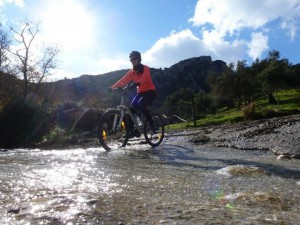Turning Personal Experiences Into ‘Homemade’ Classroom Material – Christina Markoulaki

Homemade… The word itself brings pleasant images to mind. Anything that is homemade is supposed to be of a much higher quality than ready-made stuff. This is a presupposition that seems to have comfortably established itself in our brains. What about homemade EFL materials, though? Can they be as ‘delicious’ as an ordinary course book? As much as I love using an all-inclusive course book, I would definitely argue that self-made materials have a lot to offer in the foreign-language classroom.
The main incentive for devoting personal time to prepare additional classroom activities is that they allow the teacher to cater for students’ individual needs. In a digital era, however, there are more things to consider. Personal materials are directly related to personal ownership. The latter further means that those materials can be used or disposed online in the exact way the teacher wishes them to, without having to face any copyright issues. This is utterly important, in my opinion, especially to the teachers interested in the infamous EdTech.

Turning to EdTech, most teachers, nowadays, are eager to create their own Web 2.0 activities. But when they seem to lack inspiration or the appropriate resources, what constitutes a better springboard than their own experiences? Photos and videos of hobbies, travels, personal belongings, to name but a few, could form the perfect extra activity that will attract students’ attention and ‘sting’ their curiosity, since we all know how interested they are in learning about their teachers’ personal lives.
Here are just a few ways I have turned my experiences into EFL material:
1) Having to teach the Cambridge FCE (B2 level) every single year, this is what I decided to do to spice the speaking section up a little: I chose photos from different trips I have been, all of which depicted places, this being the word group I wanted students to learn and practise using. Subsequently, I uploaded them on my blog together with nouns and adjectives commonly used to describe places. I have used this blog post with many different student groups since then and I have to admit that it forms the basis of one of my most successful speaking classes, since discussion never stops only at describing the pictures. Students then ask me about my travel experiences in each of the countries, share their dream to travel and sometimes wish to go to the exact places I have visited. If all this discussion is done in English, then it is what can be called a ‘win-win’ situation: students utilise new vocabulary, but also maintain their interest.

2) Once again aiming at teaching speaking for the FCE exams, the target word group being animal vocabulary, I uploaded a photo of my cat named Giant in an unexpected sleeping position and a photo of two fierce lions I was lucky enough to admire when I visited the Barcelona zoo years ago. Students had to compare and contrast the two (not-so-similar!) photos, also expressing their opinion on animal treatment nowadays. Of course, all students had fun with the task and responded successfully, but most importantly, they took the liberty of talking about their pets in the end, asking me a thousand questions about naughty Giant and daydreaming a little about beautiful Barcelona. They finally left written comments under my post, practising formal writing apart from speaking. I need to point out that if the discussion takes place in English and in such a positive atmosphere, then it is a glorious victory for everyone involved in the lesson.

3) The most difficult, and therefore most intriguing, athletic activity I have tried is cycling a lot of kilometres. By live streaming photos of such moments from my mobile devices to the television screen, I have managed to sparkle conversations on sports gear, weather, nature and, needless to say, students’ own pastimes. Furthermore, they always grab the chance to ask further questions concerning cycling (how often I do it, with whom, how it all started, whether I prefer mountain biking, city cycling or road cycling and so on). Therefore, whatever a teacher’s hobby may be, a couple of related photographs can sparkle intriguing conversations in a real-life context.

4) Reading books is every teacher’s favourite free-time activity, so why not transmit the wisdom obtained to the learners? For instance, as the issue of tolerance is always among the speaking and vocabulary goals during a C2-level course, I blogged an extract from Victoria Hislop’s excellent book ‘The Island’ which illustrated the concept and ignited discussion. The same blog post contains a slideshow with explanations, questions, key words and all the ‘tools’ every teacher uses, but the book extract admittedly did the trick.
5) Speaking of reading, here is some food for thought: Doesn’t a text become much more interesting if you find the person who wrote it interesting? Readers’ psychology does work in mysterious ways sometimes. Based on that, part of the online texts I suggested to my advanced learners was Barbara Goodison’s article about New Zealand, where she has moved. Barbara used to work in my school and was one of my childhood’s favourite teachers. Consequently, I had a lot of beautiful stories to share with my current students about Barbara, encouraging them to read her article and exchange opinions on it.
6) Back to teaching speaking with personal material, here is a collection of photos of animals in different zoos I have been, which can be shown on the projector or television screen for all the class to see.

7) The final link I am going to present is this Voice Thread with family scenes I often use with students to elicit their holiday news. After Christmas, to their surprise, I was willing to share private family moments (excessive food, games and a visit to the village, which are all very typical of Cretan people) in slides accompanied by questions urging learners to put their own holiday reality in words.
The logic behind all previous seven ideas is the same: sharing personal experiences in visual form can work (learning) miracles! Have you ever done a similar activity in your classroom? I would really love to read about it in the comments below.
Connect with Barb, Naomi, Christina, Pravita and other iTDi Associates, Mentors, and Faculty by joining iTDi Community. Sign Up For A Free iTDi Account to create your profile and get immediate access to our social forums and trial lessons from our English For Teachers and Teacher Development courses.




